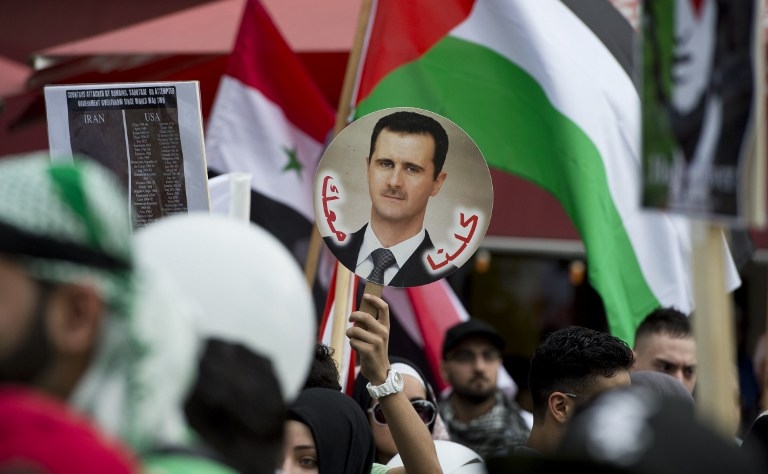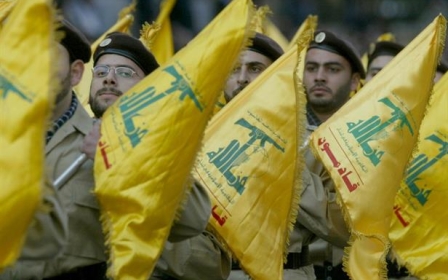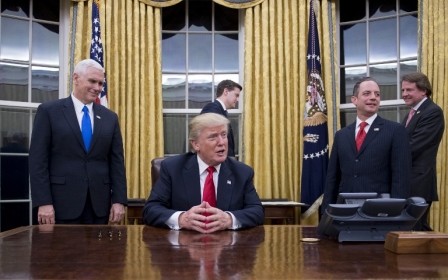But really, why is Iran still backing Assad? A psychological analysis

Six years into the Syrian civil war, Iran’s support for the Syrian regime in general and its commitment to Bashar al-Assad in particular remains resolute.
This policy has continued despite the transformation of the conflict into a war of attrition and the exponentially increasing costs of engagement for the conflicting parties including Iran, not to mention the national devastation and displacement the crisis has left in its wake.
Realists understand Iran’s intervention in Syria as an effort to keep its predominantly Shia strategic orbit - widely known as the “axis of resistance” – intact. But this interpretation doesn’t explain the country’s unwavering yet costly commitment to Assad
In fact, this type of seemingly “irrational” foreign policy behaviour is driven by significant psychological factors that Iranian decision-makers cannot afford to ignore.
Major costs
According to sources close to Staffan de Mistura, the UN special envoy for Syria, Iran is estimated to be spending $6bn a year on the Assad regime. Other estimates have put the expenditure, in terms of military and economic aid, between $15 and $20bn annually.
Beyond spending, Tehran’s controversial involvement in Syria, its first systematic intervention in a foreign country since the Islamic Revolution of 1979, has claimed, even by the most conservative tallies, the lives of more than 700 Iranian troops from the elite Revolutionary Guards and its Quds Force as well as the regular army.
More than 1,000 families of Iran-backed forces killed in Syria, including Afghans, now receive financial support from the state-backed Martyrs Foundation, according to its head Mohammad Ali Shahidi Mahallati.
Fighting on behalf of the Assad regime in an attritional war has also stretched the resources of Iran’s principal regional proxy, Hezbollah, which is estimated to have sustained losses of over 1,000 forces including top and mid-ranking commanders in the battlefield.
Some analysts believe the tally is even higher and includes approximately 2,000 dead and as many as 6,000 wounded, while the engagement has arguably posed identity challenges to the group as a primarily anti-Israel force.
Lastly, Iran’s intervention in Syria has tarnished the international image of the Islamic Republic as a self-proclaimed “leader of the Muslim world” and made it a target of Sunni fury and antipathy.
It has intensified the Iranian-Saudi rivalry with grave ramifications for regional security and stability and, more broadly, it has soured relations between Iran and the Arab sheikhdoms of the Persian Gulf, most of which are members of the Gulf Cooperation Council (GCC).
Preserving the crescent, projecting power
The most common explanation for Tehran’s long-standing involvement in the Syrian scenario against all odds and in the face of considerable material and normative costs is the Iranian leadership’s desire - and even need - to preserve the “Shia crescent” or “axis of resistance” that runs from Iraq through Syria to Lebanon.
As a result, the Islamic Republic can safely maintain a solid supply line to Hezbollah and thus project power in the Levant and the Mediterranean by keeping its archenemy Israel at bay through “asymmetric deterrence”.
Syria and the presence of a regime there that does not defy such an agenda is essential to Iran’s “strategic depth” - or so the argument goes.
Then, in event of a military conflict between Israel and Iran over the latter’s nuclear programme or any other issue, Tehran can respond not only by firing missiles at Israeli territory, but it can also rely on Hezbollah to open a front on its behalf and take the fight into enemy territory.
Strategic loneliness
This explanation may be quite convincing, but it still fails to tell us why the Islamic Republic has stuck so unabashedly to Bashar al-Assad as the “legitimate” president of Syria.
In fact, Iran has consistently obstructed international efforts, even by its allies in the Syrian war like Russia, to facilitate a transition of power from Assad to a more widely acceptable figure.
It has even gone so far as to oppose any political initiative that requires the removal of Assad as a “precondition” for peace negotiations.
Tehran could, in theory, have sacrificed Assad for the greater good or could help install a like-minded but less contentious politician in his stead, a move that would probably enable it to maintain a decisive degree of control over the Syrian state and, at the same time, avoid the enormous costs of war. The puzzle does not explain itself.
Given its geopolitical position and the security challenges on the one hand and its ideological identity and bitter historical memories of foreign intervention on the other, Iran has pursued a “revisionist” foreign policy since the 1979 revolution, with serious implications for its national security and interests.
One of these consequences is relative international isolation, or what has come to be known as “strategic loneliness”. Perhaps except for Syria, which is now engulfed in a struggle for survival, Iran still does not have strategic allies in the Middle East and beyond, and most of its conventional “friends” have not proven reliable partners at moments of crisis – such as Russia or Turkey during the Iran-Iraq war (1980-1988).
To compensate for this “alliance deficit”, Tehran has sought to build an asymmetric and unconventional support structure by cultivating like-minded “non-state” actors in the wider region, ranging from Afghanistan (Northern Alliance) to Iraq (Badr Organization) to Lebanon (Hezbollah) and Palestine (Islamic Jihad and now to a lesser extent Hamas). Notably, the common denominator of these ideological groups is their Shia religious identity.
The main problem with such non-state entities or “proxies”, however, is their extraordinary sensitivity to the foreign policy behaviour of those states that have nurtured them, primarily because these groups tend by default or by design to rely on the economic, political and military assistance of their “patrons”, despite maturing after a while and developing a life of their own.
Dangerous messages
With this in mind, Iranian strategists believe that Tehran’s abandonment of Assad would send dangerous and destabilising signals of disloyalty to the whole constellation of non-state actors under its tutelage and thus cast the Islamic Republic as an unreliable patron.
Such a development could see the slow unravelling of the unconventional alliance structure that Iran has so painstakingly forged and fostered ever since the 1979 revolution.
Unlike state actors, non-state groups do not have perennial territory or access to sustainable sources of power and wealth, and might therefore be forced to think of autonomy or other patrons once confronted with paternal disloyalty, as Hamas did after Tehran cut its financial assistance to the Palestinian group over differences about who to side with in the Syrian conflict.
For the Iranian leadership, the loss of these allies would seriously undermine Iran’s strategic depth and asymmetric deterrence.
With the loss of unconventional allies (such as Hezbollah in Lebanon or Kata’ib Hezbollah and Asa’ib Ahl al-Haq in Iraq) and in the absence of conventional ones (such as the US for Saudi Arabia), Iran would be extremely exposed to external threats and vulnerable to aggression, particularly because enduring international sanctions over the past couple of decades have denied it the opportunity to build a powerful regular military force, as say Israel or Saudi Arabia have done.
It is no wonder that at some point Iran sought, albeit surreptitiously, to attain nuclear weapons capacity or has now concentrated on developing a robust missile capability.
Importantly, this hard-headed strategic mindset is a bitter lesson of the disastrous Iran-Iraq war, where Tehran notoriously resorted to “human wave” tactics in some of its military operations and lost tens of thousands of soldiers as a result. It's an eventuality that could have been avoided with better military resources, smarter operational planning and more effective internal coordination.
At the time, Iran arguably lacked any viable deterrence, symmetric or asymmetric which is basically why Saddam Hussein felt emboldened to invade it in the first place. The Iranian leadership seems to think that a similar scenario could have been reiterated by Israel during, say, the height of tensions over Iran’s nuclear programme, had Hezbollah not been next door to deter it.
In a private conversation with an Iraqi leader, Qassem Soleimani - commander of Iran’s elite Quds Force - has been cited as saying: “We’re not like the Americans. We don’t abandon our friends.”
But Iran's loyalty and commitment to friends, including Bashar al-Assad, seems to be more strategically driven than it is emotionally or morally motivated.
- Maysam Behravesh is a PhD Candidate in the Department of Political Science and a Research Fellow in the Center for Middle Eastern Studies (CMES), Lund University. He was a senior editor of the Wiley-published journal Asian Politics & Policy and editorial assistant of the Sage-published quarterly Cooperation and Conflict. Maysam is also a regular contributor to Persian-language media outlets including BBC Persian.
The views expressed in this article belong to the author and do not necessarily reflect the editorial policy of Middle East Eye.
Photo: A demonstrator displays a placard featuring a portrait of Syrian President Bashar al-Assad that reads 'We are all with you' during a Quds Day rally in Berlin on 3 August 2013 (AFP)
This article is available in French on Middle East Eye French edition.
Middle East Eye propose une couverture et une analyse indépendantes et incomparables du Moyen-Orient, de l’Afrique du Nord et d’autres régions du monde. Pour en savoir plus sur la reprise de ce contenu et les frais qui s’appliquent, veuillez remplir ce formulaire [en anglais]. Pour en savoir plus sur MEE, cliquez ici [en anglais].





